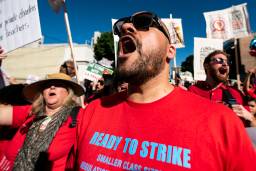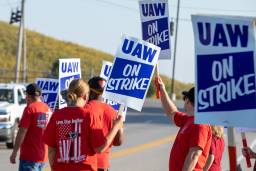During the 1950s, American workers went on strike an average of 350 times each year. In the past decade, the average number of major strikes each year fell to 20. In his new book Reviving the Strike: How Working People Can Regain Power and Transform America, veteran union negotiator and Working In These Times Contributor Joe Burns argues that grinding industries to a halt is the last, best hope for workers and their unions. Visit this site each Monday in June for exclusive excerpts from the book. Last week’s is here. —Working In These Times Editor Jeremy Gantz
With the production-halting strike becoming a relic of the past, union activists of the last 20 years have had to turn to other mechanisms to try to pressure employers during collective bargaining. Thus, we have seen the rise of strike “alternatives” such as the one-day publicity strike, the corporate campaign and the inside strategy. Each strategy, while supposedly an attempt to revive trade unionism, instead adheres to a system that has been established over the past 75 years to guarantee labor’s failure.
Without the traditional tactics of solidarity and stopping production behind them, none of these strategies had proven powerful enough to make an employer suffer economically. In many ways, these strategies are a reflection of the current state of the labor movement. Rather than putting forth bold ideas calculated to challenge the current system of labor relations in this country, contemporary trade unionists have instead adopted a philosophy of pragmatism, of making do with what the existing system offers, instead of trying to break free of that system, as traditional trade unionists once did.
Nonetheless, in recognizing the limitations of these tactics, we must still acknowledge how creative and refreshing they have been in an era of union busting and decline. They have kept alive the fighting spirit in the labor movement, particularly in situations where a traditional strike would have meant crushing defeat.
Therefore, it is important that we review these tactics so that we can understand how the contemporary labor movement operates in the absence of the traditional strike, as well as to see how, despite being limited by significant strategic shortcomings, many trade unionists still burn with the passion of the 1930s.
One-day publicity strikes
In a one-day publicity strike, the union informs management that its workers will be going on strike, but will return to work in 24 hours. Due to the short duration of the “strike” and the advance notification of the return to work, there is no opportunity for the employer to permanently replace the strikers.
However, due to their limited timeframe, one-day strikes have little impact on the operations of a company. Since the union announces its intention to strike in advance, the employer is typically able to make alternate arrangements to cover the work for the day that the workers are on strike.
The main goal of the one-day publicity strike is, as the name implies, publicity, as the union tries to bring public and media attention to the grievances of its workers. Consequently, one-day publicity strikes have generally been used against employers who are susceptible to public pressure. Frequent targets have included hospitals, universities and public employers.
Since one-day strikes are not as useful in industries that are relatively insulated from the public eye, they have not been utilized in manufacturing for the most part, although the International Union of Electronic, Electrical, Salaried, Machine and Furniture Workers did conduct a two-day strike in 2005 against General Electric, over healthcare cost increases.
Because most public employee strikes, by their very nature, are fundamentally public opinion strikes, one-day strikes have frequently been utilized in public employee negotiations. Unlike the typical private sector strike, a public employer typically saves money during a strike because they simply stop providing services, i.e. they close the motor vehicle office or stop picking up the garbage, saving money by not paying wages to strikers. The strike usually continues until community pressure demands that it be settled.
In recent years, the one-day strike has been embraced as a major strategy initiative by the SEIU. Since the mid-1990s, the union, in its core healthcare sector, has essentially abandoned any strike other than the one-day publicity strike. By analyzing data on strikes maintained by the Federal Mediation and Conciliation Service, one can see that while the SEIU engaged in frequent strikes of one to two weeks or more throughout the 1980s and early 1990s, the strategy virtually disappeared after that, to be replaced by the one-day publicity strike.
SEIU’s use of the one-day strike illustrates both the pros and the cons of the strategy. On the one hand, it has allowed SEIU to apply pressure in situations where an open-ended strike would have allowed employers to permanently replace the lower skilled healthcare workers that the union represents. In addition, the one-day strike has allowed membership participation in the bargaining process beyond mere picketing or rallies.
However, despite the limited good that the one-day publicity strike does, what does it mean for the labor movement when one of the largest unions in the country has all but abandoned the traditional strike? In adopting a tactic that cannot produce significant gains for workers, the SEIU has essentially surrendered. At their best, the one-day strike supplies the illusion of struggle, distracting from the real problems facing the labor movement, which is the lack of an effective traditional strike.
Inside strategy: working to rule
Working to rule, also known as the inside strategy, is based on employees strictly following the employer’s own rules in order to impact production. As described in “A Troublemaker’s Handbook II,” “Working to rule is not exactly the same as a slowdown and it is not sabotage, neither of which are legally protected union activities. Working to rule generally means restricting output, undermining quality, or cutting back on service by working strictly by the book.” By using the employer’s rules against them, the workers attempt to control the plant from the inside.
A great example of working to rule was the 2003 campaign waged by the Communications Workers of America against Verizon. With the company hiring 30,000 replacement workers in preparation for a strike, the CWA realized that it needed a radical strategy to keep its workers from losing their jobs. Thus, right before the strike deadline, the union announced that it would stay on the job and keep negotiating. Employees then followed Verizon’s work rules to the letter, such as delaying “the start of their days with a 20-minute truck safety check” or refusing “to use fire escapes, which forced management to find other ways to gain access to phone boxes.”
After a month of working without a contract, the working to rule strategy, combined with a simultaneous campaign to mobilize public support, prompted Verizon to settle. The union was able to beat back management’s attempts to force concessions, winning what one official called a “defensive victory.”
Like other strategies discussed here, working to rule has proven able to supplement, but not replace, a strike that stops production. There are also limitations on how far the union can push the strategy without it being deemed a slowdown. Furthermore, if the activities continue after the expiration of a contract, the employer can legally impose the concessions they were seeking during bargaining once the negotiations are at an impasse.
While the inside strategy belongs in any trade unionist’s toolbox, because of its many inherent weaknesses, it cannot take the place of a traditional strike.
Corporate campaigns
In a corporate campaign, unions pressure employers by a variety of means, including legal and regulatory challenges, boycotts, forming alliances with community groups, or by attacking business allies of a targeted employer. The idea is to hit the corporation from as many points of attack as possible.
By their very nature, corporate campaigns rely on a mixture of tactics. For example, one campaign might focus on interlocking boards of directors, while another might put more effort into pressuring suppliers.
For instance, during the Detroit News strike of the mid-1990s, “road warriors” followed members of the board of directors of the Gannet newspaper chain, owner of the newspaper, around the country, confronting them whenever the chance arose. During the Staley lockout in 1995, workers engaged in a boycott of the “end user” of the struck product, which was corn syrup. Since it is obviously impossible to boycott a product like corn syrup, the workers instead targeted an end user that used the product, in this case Miller beer.
Compared to the ineffective strikes of the 1980s and 1990s, the corporate campaign is a quantum leap forward, as rather than standing on dreary picket lines, waiting for scabs to take their jobs, strikers actually go after the company.
Despite their advantages, however, even a well-run corporate campaign can only produce limited results. While, in certain instances, a corporate campaign has forced an employer back to the bargaining table, rarely has it produced outright victory for labor. Many tactics of the corporate campaign, while laudatory, have had negligible effect, such as targeting individuals of a corporation’s board of directors, as in the Detroit News strike. While this provides fodder for some good publicity, it is unclear how getting a company to drop a member of its board of directors has much impact on the outcome of a strike.
Overall, the corporate campaign has proven unable to substitute for a traditional strike that cripples production. First, time is on the side of the employer. As we have seen, after one year of an economic strike, only scabs can vote in an NLRB election at a struck plant. That means an employer can wait one year, and then have the scabs vote the union out.
Corporate campaigns also take a long time to get up and running, time a union often does not have. This is why they have generally worked better in a lockout or unfair labor practice strike, where the employer can only hire temporary replacement workers. Corporate campaigns are also very labor intensive and require a large commitment of resources from unions, which many are unable or unwilling to offer. (A notable exception is the Steelworkers union, which has been willing to spend millions of dollars on corporate campaigns).
Finally, and most damaging, an employer is able to continue operations during a corporate campaign. The scabs enter the plant and the product keeps coming out. As labor writer Jane Slaughter noted in the early 1990s:
…a corporate campaign that targets the power structure is a valuable tactic, but it must be combined with the ability to hurt the company’s pocket book directly. … It also means — easier said than done — finding a way to keep the company from continuing production with scab labor. This requires the willingness to face injunctions and arrests and to ask allies to do the same.
While the corporate campaign can, on occasion, work in conjunction with a strike strategy, it will never replace a strike that halts production.
From REVIVING THE STRIKE: How Working People Can Regain Power and Transform America by Joe Burns. Copyright © 2011 by Joe Burns. Reprinted with permission of Ig Publishing, Inc.

I hope you found this article important. Before you leave, I want to ask you to consider supporting our work with a donation. In These Times needs readers like you to help sustain our mission. We don’t depend on—or want—corporate advertising or deep-pocketed billionaires to fund our journalism. We’re supported by you, the reader, so we can focus on covering the issues that matter most to the progressive movement without fear or compromise.
Our work isn’t hidden behind a paywall because of people like you who support our journalism. We want to keep it that way. If you value the work we do and the movements we cover, please consider donating to In These Times.
Joe Burns, a former local union president active in strike solidarity, is a labor negotiator and attorney. He is the author of the book Reviving the Strike: How Working People Can Regain Power and Transform America (IG Publishing, 2011).







